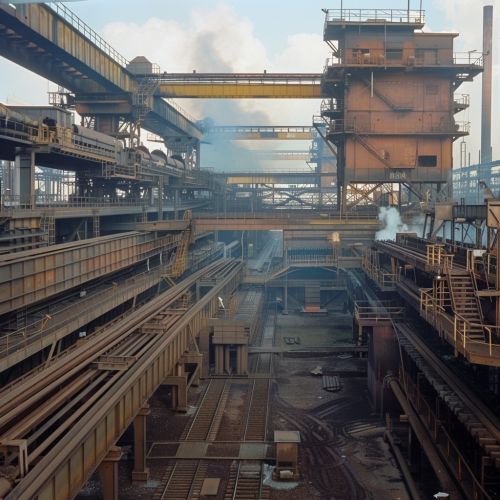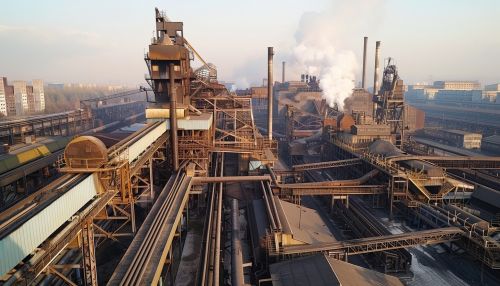Steel
Introduction
Steel is an alloy made predominantly of iron, with small amounts of carbon and sometimes other elements. It is one of the most commonly used materials in the world, with applications ranging from construction and infrastructure to appliances and vehicles. Its properties, such as strength, durability, and resistance to heat and corrosion, make it an ideal material for many uses.
History
The production of steel dates back to ancient times, with the earliest examples of steel artifacts found in East Africa dating back to 1400 BC. The process of making steel involved heating iron in a bloomery, where it absorbed carbon from the charcoal. This early form of steel, known as wrought iron, was used for tools and weapons.
In the 17th century, the blast furnace was developed, which allowed for the mass production of iron. However, the iron produced in these furnaces was brittle and not suitable for many applications. It wasn't until the 19th century that the Bessemer process was developed, allowing for the production of steel on an industrial scale.
Composition
Steel is primarily composed of iron and carbon. The carbon content in steel typically ranges from 0.2% to 2.1% by weight. The presence of carbon in steel significantly increases its hardness and strength but decreases its ductility.
In addition to carbon, steel can also contain other elements, either as impurities or intentionally added to enhance certain properties. These elements include manganese, silicon, phosphorus, sulfur, and sometimes nickel and chromium. Each of these elements can affect the properties of the steel in different ways.
Types of Steel
There are several different types of steel, each with its own unique properties and uses.
Carbon Steel
Carbon steel is a type of steel where the primary alloying element is carbon. It is divided into three categories: low carbon steel, medium carbon steel, and high carbon steel. The carbon content in these types of steel ranges from less than 0.3% in low carbon steel to 0.6%-1.4% in high carbon steel.
Alloy Steel
Alloy steel is a type of steel that contains additional alloying elements other than carbon to improve its mechanical properties. These elements can include manganese, nickel, chromium, molybdenum, vanadium, silicon, and boron.
Stainless Steel
Stainless steel is a type of steel that contains a minimum of 10.5% chromium, which gives it its corrosion resistance. It is used in a wide range of applications, from cutlery and kitchen appliances to medical instruments and architectural structures.
Production
The production of steel involves several steps, including the extraction of iron ore, the production of pig iron, and the conversion of pig iron to steel.
The first step in the production of steel is the extraction of iron ore. This is done in mines, where iron ore is extracted from the earth. The iron ore is then transported to a steel mill, where it is converted into pig iron.
The pig iron is then converted into steel using one of several methods, including the basic oxygen process, the electric arc furnace, and the open hearth process.
Applications
Steel is used in a wide range of applications due to its strength, durability, and versatility. Some of the most common uses of steel include:
- Construction: Steel is used in the construction of buildings, bridges, and other structures due to its strength and durability.
- Transportation: Steel is used in the production of cars, trucks, trains, and ships due to its strength and resistance to corrosion.
- Appliances: Steel is used in the production of appliances such as refrigerators, washing machines, and ovens due to its durability and heat resistance.
- Tools: Steel is used in the production of tools due to its hardness and durability.
Environmental Impact
The production of steel has a significant environmental impact, including the emission of greenhouse gases, the consumption of energy, and the generation of waste. However, efforts are being made to reduce the environmental impact of steel production, including the development of more efficient production methods and the recycling of steel.
Future of Steel
The future of steel is likely to be influenced by a number of factors, including technological advancements, environmental concerns, and economic factors. Technological advancements may lead to the development of new types of steel with improved properties, while environmental concerns may lead to changes in the methods used to produce steel.


